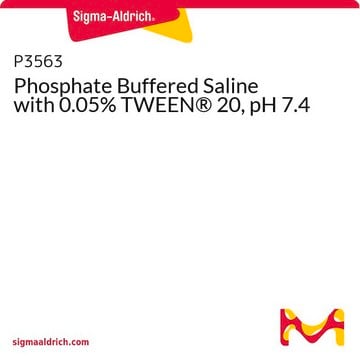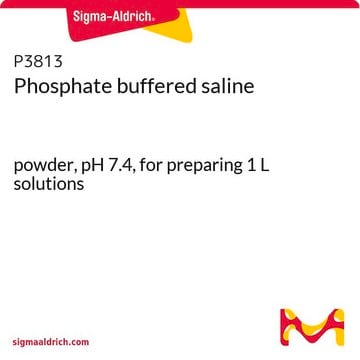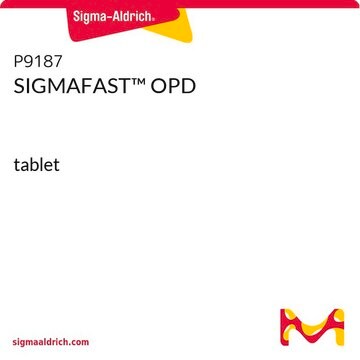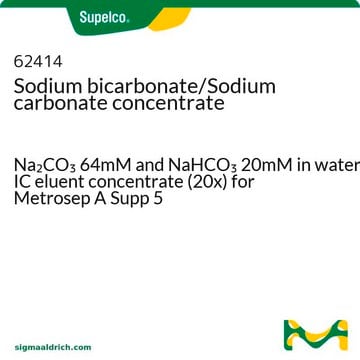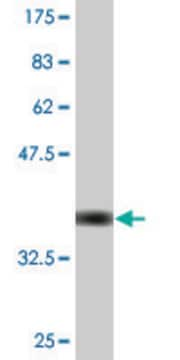Unfortunately, the long term stability of the prepared solution has not been determined. However, prepared solutions are expected to be quite stable. Similar Sodium Carbonate/Bicarbonate 20X solutions are assigned a 2 year shelf life. Provided that solutions are stored refrigerated and not contaminated, a comparable shelf life is expected. Solutions should be observed for any changes in color and turbidity. Please see the link below to review the prepared 20X Concentrate product options:
https://www.sigmaaldrich.com/substance/sodiumbicarbonatesodiumcarbonateconcentrate1234598765
C3041
Carbonate-Bicarbonate Buffer
capsule
Sinónimos:
Carbonate Buffer Solution
About This Item
Productos recomendados
Formulario
capsule
Nivel de calidad
pH
9.3-9.9
solubilidad
water, high purity: 1 capsule/100 mL
aplicaciones
diagnostic assay manufacturing
Categorías relacionadas
Descripción general
Aplicación
Reconstitución
Opcional
Palabra de señalización
Warning
Frases de peligro
Consejos de prudencia
Clasificaciones de peligro
Eye Irrit. 2
Código de clase de almacenamiento
13 - Non Combustible Solids
Clase de riesgo para el agua (WGK)
WGK 1
Punto de inflamabilidad (°F)
Not applicable
Punto de inflamabilidad (°C)
Not applicable
Elija entre una de las versiones más recientes:
Certificados de análisis (COA)
¿No ve la versión correcta?
Si necesita una versión concreta, puede buscar un certificado específico por el número de lote.
¿Ya tiene este producto?
Encuentre la documentación para los productos que ha comprado recientemente en la Biblioteca de documentos.
Los clientes también vieron
Protocolos
Detailed ELISA protocols cover indirect and capture ELISA techniques, recommending products for sandwich and indirect ELISA experiments.
Detailed ELISA protocols cover indirect and capture ELISA techniques, recommending products for sandwich and indirect ELISA experiments.
Detailed ELISA protocols cover indirect and capture ELISA techniques, recommending products for sandwich and indirect ELISA experiments.
Detailed ELISA protocols cover indirect and capture ELISA techniques, recommending products for sandwich and indirect ELISA experiments.
-
If I make a solution and there are reagents left, how long can it be stored? What should I do with the storage conditions?
1 answer-
Helpful?
-
-
How can I determine the shelf life / expiration / retest date of this product?
1 answer-
If this product has an expiration or retest date, it will be shown on the Certificate of Analysis (COA, CofA). If there is no retest or expiration date listed on the product's COA, we do not have suitable stability data to determine a shelf life. For these products, the only date on the COA will be the release date; a retest, expiration, or use-by-date will not be displayed.
For all products, we recommend handling per defined conditions as printed in our product literature and website product descriptions. We recommend that products should be routinely inspected by customers to ensure they perform as expected.
For products without retest or expiration dates, our standard warranty of 1 year from the date of shipment is applicable.
For more information, please refer to the Product Dating Information document: https://www.sigmaaldrich.com/deepweb/assets/sigmaaldrich/marketing/global/documents/449/386/product-dating-information-mk.pdfHelpful?
-
-
How is shipping temperature determined? And how is it related to the product storage temperature?
1 answer-
Products may be shipped at a different temperature than the recommended long-term storage temperature. If the product quality is sensitive to short-term exposure to conditions other than the recommended long-term storage, it will be shipped on wet or dry-ice. If the product quality is NOT affected by short-term exposure to conditions other than the recommended long-term storage, it will be shipped at ambient temperature. As shipping routes are configured for minimum transit times, shipping at ambient temperature helps control shipping costs for our customers. For more information, please refer to the Storage and Transport Conditions document: https://www.sigmaaldrich.com/deepweb/assets/sigmaaldrich/marketing/global/documents/316/622/storage-transport-conditions-mk.pdf
Helpful?
-
Active Filters
Nuestro equipo de científicos tiene experiencia en todas las áreas de investigación: Ciencias de la vida, Ciencia de los materiales, Síntesis química, Cromatografía, Analítica y muchas otras.
Póngase en contacto con el Servicio técnico

